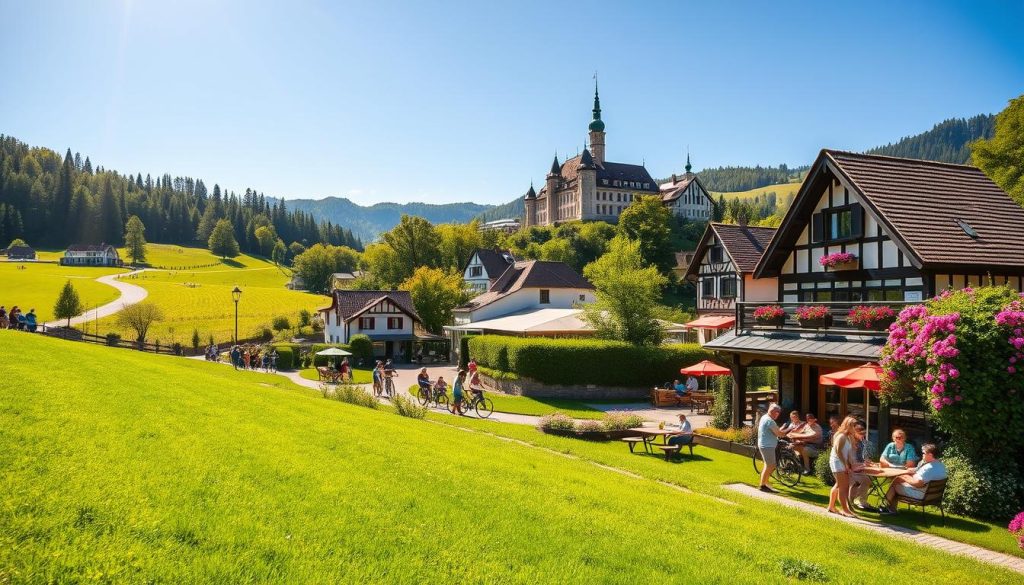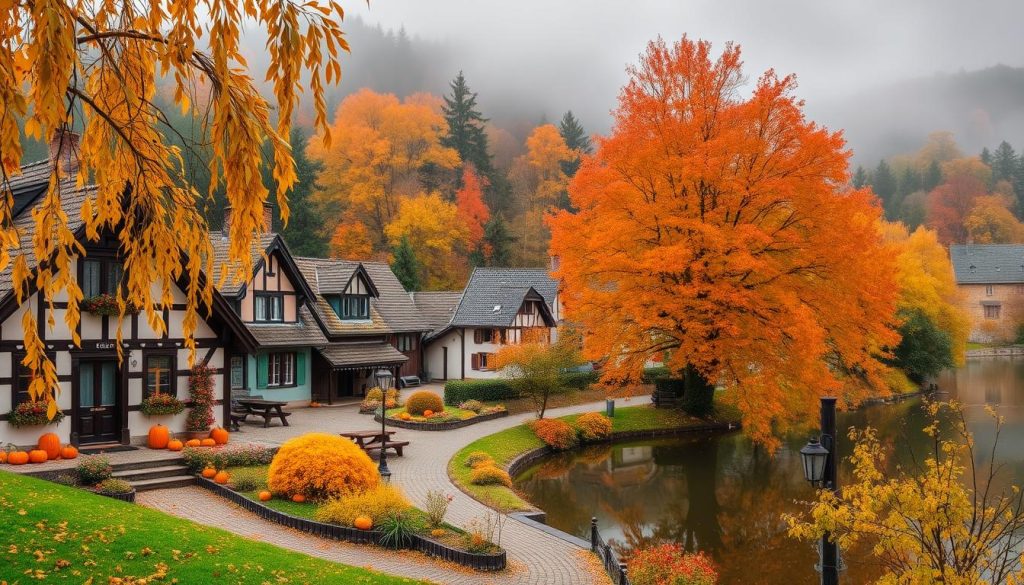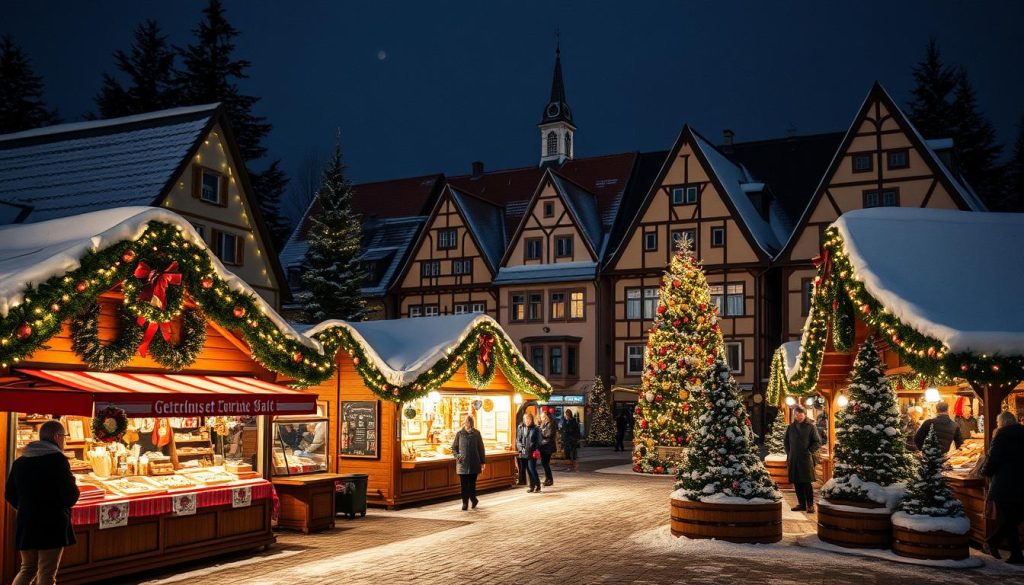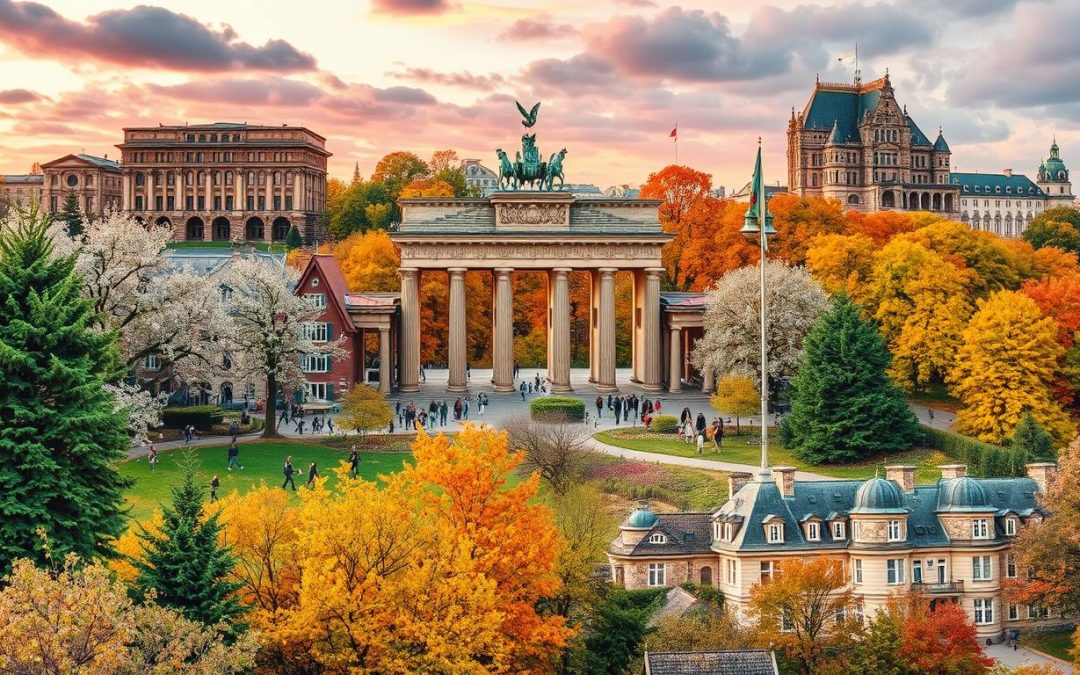Are you dreaming of exploring Germany’s beautiful landscapes? Want to dive into its rich culture and enjoy lively festivals? Germany has 16 national parks and a mild climate all year. But when is the best time to visit this magical place?
Germany’s weather changes a lot, from the Bavarian Alps in the south to the northern coast. You can find warm summer days, cozy winter, or the colors of spring and fall. This guide will help you pick the perfect time for your trip to Germany.
Key Takeaways
- Germany’s weather is mild year-round, with distinct seasons offering different experiences
- May and June are considered the best months to visit, with reliable weather and fewer crowds
- Summer in Germany (June-August) brings consistent warm temperatures and lively festivals
- Shoulder seasons (spring and fall) offer lower prices and fewer tourists compared to peak season
- Winter in Germany (December-February) brings magical Christmas markets and snow-capped landscapes
Overview of Germany’s Travel Seasons
Planning a trip to Germany means knowing the different travel seasons. Each season offers unique experiences and things to consider. From the busy peak season to the quiet off-season, there’s something for everyone.
Peak Season (June-August)
The peak season is from June to August, the warmest and busiest time. It’s great for outdoor fun, festivals, and enjoying the sun. With temperatures between 68°F and 77°F, it’s perfect for cultural events and lively vibes.
Shoulder Season (March-May, September-November)
The shoulder seasons are March to May and September to November. They offer milder weather, fewer people, and lower prices. Spring brings temperatures from 47°F to 68°F, while autumn is cooler but sunnier.
Off-Season (December-February)
The off-season is from December to February, with colder weather and fewer visitors. But, it’s special for Christmas markets and winter sports in southern Germany. It’s a chance for a unique, authentic experience.
Germany’s travel seasons each have their own perks and things to think about. Whether you want summer festivals, autumn wine, or Christmas markets, there’s a season for you. Knowing what each season offers helps plan your trip for the best experience.
Best Time to Visit Germany: May and June
May and June are the top seasons to see Germany’s beauty. These months have warm days, cool nights, and blooming nature. They are the best times for many travelers.
Spring brings cherry blossoms to Germany’s streets, making it magical. May 1st kicks off the festival season with maypole celebrations everywhere.
The weather is lovely, with temperatures from 37°F to 75°F in cities like Berlin, Cologne, and Frankfurt. While crowds grow, they’re not too big yet. This makes visiting popular spots more fun.
Also, Germany’s festival scene is buzzing. Events like the Berlin Culture Festival and the Freiburg Wine Festival attract visitors worldwide.
If you love culture, nature, or mild weather, May and June are perfect. They offer a great chance to enjoy Germany’s heritage and beauty5.
Summer in Germany: What to Expect
Germany’s summer, from June to August, is perfect for exploring the country’s lively culture and stunning landscapes7. The weather is warm, festivals are exciting, and the crowds are lively. It’s a great time to visit Germany.
Weather and Temperatures
July and August are the warmest months, with temperatures between 70-75°F (21-24°C) in most cities8. The weather is mostly nice, with some thunderstorms and rain to cool things down8. Places like Karlsruhe, Mainz, and Frankfurt have great summer weather8.
Popular Summer Festivals
Germany’s summer is packed with festivals that attract visitors from everywhere7. Highlights include the Schützenfest in Hannover, the Freiburg Wine Festival, and the Berlin Culture Festival in July7. In August, the Frankfurt Apple Wine Festival celebrates the region’s favorite drink7.
Crowding and Tourism
Summer is the busiest time in Germany, with lots of people and long lines at popular spots7. Cities like Munich, Berlin, and Frankfurt get very crowded7. To avoid the hassle, book your stay and tours early7.

Fall Experience: September and October
Germany comes alive with autumn colors in September and October. These months have mild weather and beautiful fall foliage. They are perfect for outdoor fun and exploring Germany’s culture5.
The Oktoberfest in Munich is a highlight of fall. It happens in late September and early October. Millions visit to enjoy German beers, food, and fun5.
September and October are also great for wine lovers. Germany’s wine regions host festivals like the Rheingau Wine Festival in Frankfurt. These events celebrate German wine and offer a taste of the finest vintages9.
Traveling in September and October can be more affordable. There are fewer crowds and lower prices for places to stay and things to do. It’s a good time to see Germany’s landscapes and cities9.
 The fall season in Germany is captivating. You can enjoy lively festivals, beautiful nature, and a slower pace of life. From Berlin’s streets to the Bavarian Alps, it’s a memorable trip9.
The fall season in Germany is captivating. You can enjoy lively festivals, beautiful nature, and a slower pace of life. From Berlin’s streets to the Bavarian Alps, it’s a memorable trip9.
Winter Magic: December Through February
Germany turns into a winter wonderland from December to February. It’s a magical time to visit, with Christmas markets, winter sports, and more. This season is perfect for exploring the country10.
Christmas Markets
Germany’s winter is famous for its Christmas markets. These markets, open from late November to Christmas Eve, offer local crafts, tasty treats, and hot drinks10. Berlin has about 80 markets, making it a top spot for holiday cheer10.
Other great markets are in Leipzig, Nuremberg, and Dresden. Dresden has Germany’s oldest Christmas market10.
Winter Sports and Activities
The Bavarian Alps are perfect for winter sports. Garmisch-Partenkirchen is a favorite for skiing and snowboarding10. Resorts open after Christmas, offering fun all winter11.
Winter Weather Considerations
Winter in Germany is cold, with highs around 39°F (4°C) in Berlin and 43°F (6°C) in Frankfurt10. The Bavarian Alps are even colder, with lows around 23°F (-5°C) in December10. Snow is common, especially late in the month11.
Despite the cold, Germany’s winter is magical. It’s a great time for festive celebrations like Carnival in Mainz, Düsseldorf, and Cologne11.
 Visiting Germany in winter is a unique and magical experience. You can enjoy Christmas markets, winter sports, and more. Whether you want a cozy holiday or an exciting adventure, Germany’s winter wonderland has it all1011.
Visiting Germany in winter is a unique and magical experience. You can enjoy Christmas markets, winter sports, and more. Whether you want a cozy holiday or an exciting adventure, Germany’s winter wonderland has it all1011.
Spring Revival: March Through May
Germany’s landscapes burst into life as winter fades. From March to May, the country is filled with food, music, and festivals celebrating spring’s arrival12. The weather is a mix of sunny days and rain, with temperatures from 0°C to 19°C. It’s perfect for outdoor fun and discovery.
Cherry blossoms are a highlight of German spring13. The Eggenertal valley, near Freiburg, is famous for its blooming cherry trees13. Stuttgart’s Wilhelma Zoo and Botanical Gardens also have a stunning magnolia grove, with over 70 trees in full bloom.
Spring in Germany is full of festivals and events14. The Stuttgart Spring Festival and Berlin’s Carnival of Cultures are just a few highlights12. Visiting Central Europe in April and May is great for enjoying mild weather and outdoor attractions.
| Event | Location | Date |
|---|---|---|
| Stuttgart Spring Festival | Stuttgart | April – May |
| Berlin’s Carnival of Cultures | Berlin | May – June |
| Starkbierfest (Strong Beer Festival) | Munich | March – April |
The Starkbierfest, or “Strong Beer Festival,” in Munich is a must-see14. It’s a less crowded alternative to Oktoberfest. Visitors can enjoy the country’s brewing heritage and try robust Bock beers.
“The best time to visit Central Europe is generally during the spring months of April to June and the fall months of September to October.”12
Germany’s March to May season is perfect for seeing cherry blossoms, cultural events, and the spring transition14. It’s a wonderful time to explore the country and its rich heritage and natural beauty.
Regional Weather Variations
When planning your trip to Germany, it’s key to know the different weather patterns across the country. From the cooler northern coasts to the warmer south, understanding these variations is crucial. It helps you enjoy your time in this beautiful country to the fullest.
Northern Germany Climate
The northern parts of Germany, like the North German coast, have a cooler climate. This is due to the North and Baltic Seas. Temperatures average around 9°C15 yearly, with about 700 mm15 of rain annually. Summers are mild, perfect for beach activities and visiting seaside towns.
Southern Germany and Bavaria
Southern Germany and Bavaria have a warmer climate, with temperatures around 9.5°C15 yearly. The Alps in these areas get cold winters with lots of snow. This makes them great for winter sports. Rainfall can be up to 2000 mm15 in these regions.
Central Germany Weather Patterns
Central Germany, with cities like Frankfurt and Nuremberg, has a moderate climate. It’s influenced by both continental and maritime climates. Temperatures average about 8.5°C15 yearly, with 600 mm15 of rain. Summers are warm, while winters are cold, offering a variety of experiences for visitors.
| Region | Average Annual Temperature | Average Annual Precipitation |
|---|---|---|
| North and Northwest Germany | 9°C15 | 700 mm15 |
| East Germany | 8.5°C15 | 600 mm15 |
| Central and Southern Germany | 9.5°C15 | 800 mm15 |
| Alpine and Mountainous Regions | 5°C15 | 2000 mm15 |
Knowing the regional climate patterns helps you plan your German trip better. It ensures you have a memorable experience16.
Essential Travel Tips for Every Season
Planning a trip to Germany means being ready for its varied climate and cultural scenes. Whether you’re here in summer or winter, these tips will enhance your German experience.
- Pack Comfortable Walking Shoes: Germany’s cities are best explored on foot, so invest in a good pair of comfortable walking shoes. This will allow you to navigate the cobblestone streets and historic districts with ease17.
- Bring a Travel Adapter: Germany operates on a 230V electrical supply, so you’ll need a two-pronged cylindrical travel adapter to power your electronic devices18.
- Dress in Layers: Germany’s weather can be unpredictable, with temperatures and precipitation levels varying across different regions17. Pack a light raincoat or compact umbrella to be prepared for unexpected showers17.
- Check Mobile Network Compatibility: Ensure your mobile phone is compatible with the German network before your trip to stay connected during your travels17.
- Verify Passport Validity: Make sure your passport is valid for at least six months from your departure date to avoid any issues at border control17.
- Consider a Rail Pass: Germany has an excellent public transportation system, and a rail pass can be a cost-effective way to explore the country17.
- Book Accommodations and Attractions in Advance: During peak seasons and festivals, popular attractions and accommodations can sell out quickly, so it’s best to book well in advance17.
By following these tips, you’ll be ready to enjoy Germany’s culture, landscapes, food, and hospitality17.
| Tip | Details |
|---|---|
| Comfortable Walking Shoes | Germany’s cities are best explored on foot, so invest in a good pair of comfortable walking shoes. This will allow you to navigate the cobblestone streets and historic districts with ease17. |
| Travel Adapter | Germany operates on a 230V electrical supply, so you’ll need a two-pronged cylindrical travel adapter to power your electronic devices18. |
| Dress in Layers | Germany’s weather can be unpredictable, with temperatures and precipitation levels varying across different regions17. Pack a light raincoat or compact umbrella to be prepared for unexpected showers17. |
| Mobile Network Compatibility | Ensure your mobile phone is compatible with the German network before your trip to stay connected during your travels17. |
| Passport Validity | Make sure your passport is valid for at least six months from your departure date to avoid any issues at border control17. |
| Rail Pass | Germany has an excellent public transportation system, and a rail pass can be a cost-effective way to explore the country17. |
| Advance Bookings | During peak seasons and festivals, popular attractions and accommodations can sell out quickly, so it’s best to book well in advance17. |
By following these tips, you’ll be ready to enjoy Germany’s culture, landscapes, food, and hospitality17.
Conclusion
Choosing the best time to visit Germany depends on what you like to do and see19. Summer, from June to August, is great for outdoor fun and festivals with warm weather20. But, it’s also the busiest time, with more people and higher prices19.
If you’re watching your budget, consider visiting in the shoulder seasons. March to May and October to November have fewer people and lower prices19.
Germany has something for everyone all year round19. You can enjoy Oktoberfest in Munich, Christmas markets, or the Berlin Film Festival19. The weather varies by region, offering unique experiences21.
So, the best time to visit Germany is based on your travel plans20. Think about the weather, crowds, and events to plan the perfect trip. Germany is a wonderful place to explore, no matter when you go192021.

